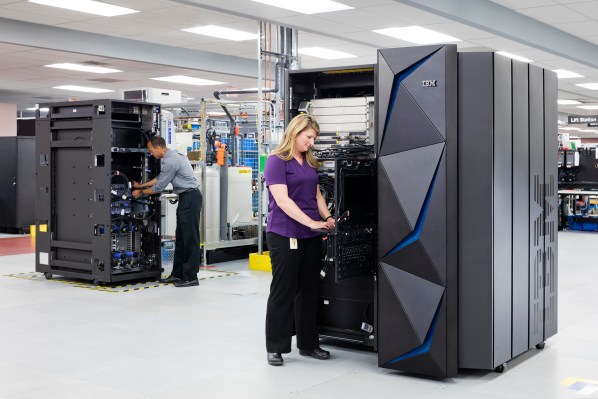IBM is doing its damnedest to keep the mainframe relevant in a modern context, and believe it or not, there are plenty of monster corporations throughout the world who still use those relics from the earliest days of computing. Today, the company unveiled the z14, its latest z-Series mainframe, which comes with the considerable draw of full encryption.
Is that enough for even corporate giants to shell out the dough for one of these computing behemoths? IBM’s general manager of z Systems Ross Mauri says the company spent two years talking to 150 customers to get a grip on exactly what it would take for them to upgrade their current mainframe technology, and what they kept hearing was “encrypt everything so we don’t have to worry about it.”
And that’s precisely what Mauri says IBM set out to do with the latest release. “[Full Encryption] was the most needed capability, and it solves a real-world problem. There’s a cyber war out there with highly funded groups looking for data and getting it. Our purpose [with z14 encryption] is shutting that down,” he said.
The way they are doing it is by encrypting every level of the system, and then storing everything inside encrypted containers. What’s more, if the system detects an attack like malware or other intrusion, it has been designed to shut itself down automatically. As Mauri said, even if hackers could somehow get through all of these defenses, the encryption would render the data useless.
Peter Rutten, an analyst with IDC says all-encompassing encryption is clearly the key to this release. “It’s like a security blanket across the entire system — database, applications, data at rest, data in flight, APIs, etc. — that can just be turned on, rather than manually picking and choosing what to encrypt, which typically has led to much [data] remaining unencrypted,” he explained.
Beyond pure encryption, customers also told IBM they wanted this capability delivered in a cost-effective way. Of course, IBM is promising this, and has revealed a new pricing strategy called a “container pricing model,” but Mauri wouldn’t discuss details, so it’s difficult to know exactly how the company defines “cost-effective.”
Pund-IT analyst Charles King says, however, that the container pricing approach has the potential to be more cost-effective in the long run than earlier mainframe pricing schemes. “Container pricing is a more flexible approach that should result in system billing more accurately reflecting the amount of work the system is used to accomplish [a given task], thus making the z14 (and z13, since container pricing will also be available for those systems) more cost-effective,” King said.
All that said, it’s probably going to take more than total encryption for a company to spring for a mainframe unless it’s core to their business, according to analyst Roger L. Kay from the firm, Endpoint Technologies Associates, Inc. “No, I don’t think a company would buy a mainframe just for the encryption. But companies that need mainframes to run the backbone of large, complex business systems will find the upgrade to z14 worthwhile,” he said.
Mauri wouldn’t discuss specific sales projections, but he sounded confident that the latest z model was going to sell well. After more than two years of talking to customers, and building the exact system they asked for, it would appear he has every reason to.
